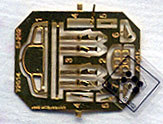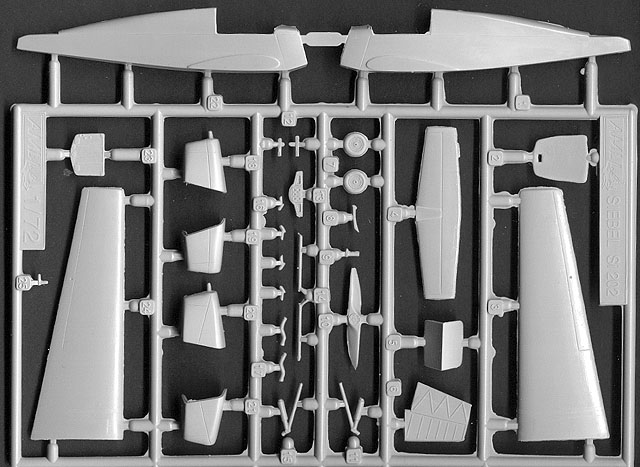|
Siebel
Si 202 Hummel
AML


AML's
1/72 scale Si 202 is available online from Squadron.com
S
u m m a r y
|
| Catalogue Number: |
72 014 |
| Scale: |
1/72 |
| Contents and Media: |
30 parts in injected
grey styrene; 1 photo-etched fret;
1 small acetate sheet; 2 clear parts on a small vacform sheet. |
| Price: |
USD$12.96 from Squadron.com |
| Review Type: |
First Look |
| Advantages: |
Good quality plastic; appropriate
surface detail; effective use of photo-etched parts; simple
construction; alternate cowl provided for Si 202C variant |
| Disadvantages: |
Vacform canopy will need care in
cutting out and blending in to fuselage; wing-to-fuselage join will need
reinforcement and care in alignment; fine flash needs removing; same wing supplied
both variants. |
| Recommendation: |
Recommended to experienced
limited-run modellers |
Reviewed by
Brett Green
AML's most recent release in
1/72 scale is their Siebel Si 202 Hummel.
This is a relatively obscure
aircraft that first flew in 1938. A total of 66 Hummels (Bumblebee) were
manufactured. They were used in training, general transport and
communications roles.
 AML's Hummel comprises 30 parts
in injection moulded styrene, one photo etched fret with harnesses and
parts for the instrument panel, a small acetate sheet with printed
instruments, two vacform parts (a canopy and a spare) plus markings for
three aircraft. These contents are packed neatly into a satisfyingly
solid cardboard box. AML's Hummel comprises 30 parts
in injection moulded styrene, one photo etched fret with harnesses and
parts for the instrument panel, a small acetate sheet with printed
instruments, two vacform parts (a canopy and a spare) plus markings for
three aircraft. These contents are packed neatly into a satisfyingly
solid cardboard box.
The package presents the
impression of a high quality product. The plastic parts are limited-run
in origin, but the sprue connection points are quite fine and surface
detail is very crisp. Fine flash is present in places, and a few large
ejector pics will have to be removed from the mating surfaces of the
fuselage, but these tasks will only take a few minutes. It should also be noted that surface detail is
quite scarce, as is appropriate for this wooden aeroplane. Where
applicable, panel lines are engraved. The fin seems to feature a raised
pressed metal finish.

Cockpit detail is sparse, but
represents the main features of this simple aircraft. Bench seats are a
relative rarity in the cockpit of a military aircraft, but at least it
looks comfortable!
Construction should be
straightforward with careful preparation. The absence of locating pins
makes it essential to dry-fit parts prior to committing to adhesive.
This will be especially important when securing the undercarriage legs.
There is no indication of where the struts meet the fuselage, so care
will be required. The
tailplanes are cleverly designed with full-span horizontal surfaces and
a separate fin. This should ensure a fairly solid join, although some
wire reinforcement for the fin may be a wise precaution. The wings are
supplied as one piece each. The trailing edges are quite thin. The wings
form a
simple butt-join (ie, no slots, tabs or other locating points) with the
fuselage. I strongly recommend drilling the fuselage and fitting rod
reinforcement for these large joins, and taking extra time to ensure the
correct dihedral is set.
Two of the options are for
early Si 202s. An alternate cowl is also provided for the later Si 202C.
This variant featured a more powerful engine (grinding out a mighty 60
horsepower) and a 10cm increase in wingspan. AML have made no attempt to
depict this variation in wingspan. The difference scales out to 2mm, so
it will be up to the modeller to determine if the extra effort is
worthwhile.
The canopy is supplied as a
thin vacform part. This will probably be the trickiest part of
construction, as the vacform part must be "blended" with the
upper fuselage for a flat join.
 Instructions are supplied on
two folded A-4 sheets. A brief history and parts list is followed by six
steps of assembly illustrations. Four-view diagrams are supplied for
each of the three marking options. Instructions are supplied on
two folded A-4 sheets. A brief history and parts list is followed by six
steps of assembly illustrations. Four-view diagrams are supplied for
each of the three marking options.
AML's Si 202 Hummel looks like
a high-quality model. Anyone with limited-run modelling experience
(especially with vacform canopies) should be able to produce a nice
replica of the Hummel straight from the box.
Recommended.
Thanks to Squadron
for the review sample.
Review and Images Copyright © 2001 by Brett
Green
Page Created 12 December, 2001
Last updated 22 July, 2003
Back to HyperScale Main Page
Back to Reviews Page
|
Home | What's
New | Features
| Gallery |
Reviews | Reference
| Forum
| Search